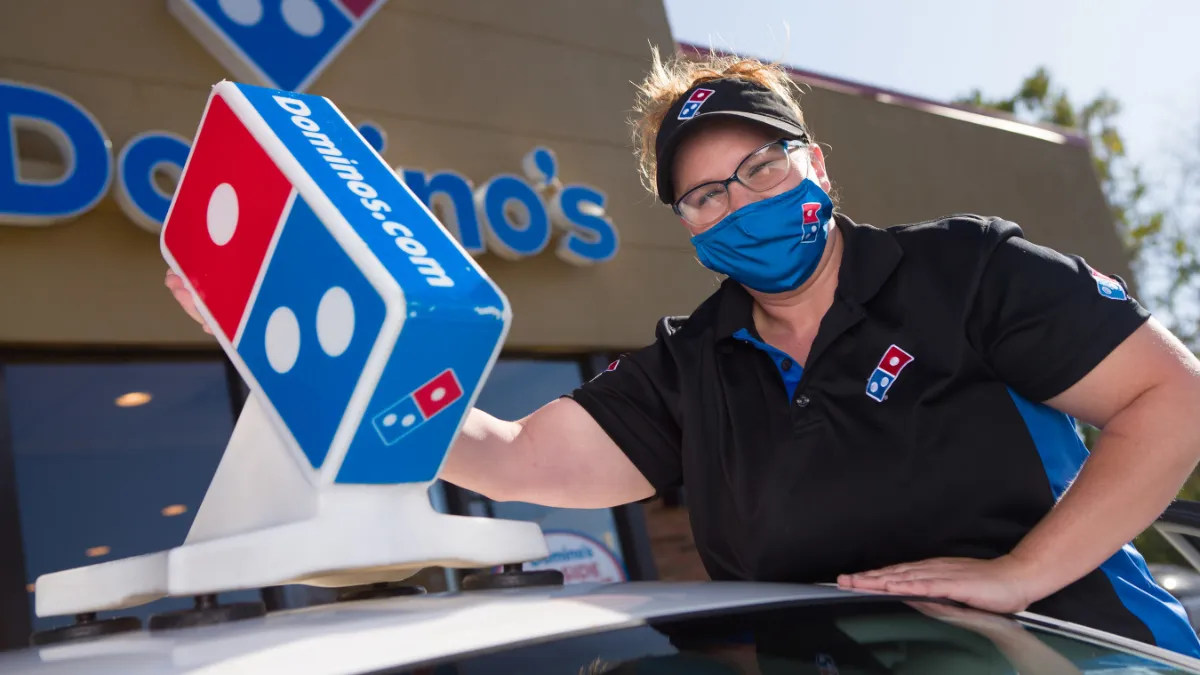Dive Brief:
- Forty-four percent of drivers prefer the scheduling flexibility offered by ride-sharing providers like Uber and Lyft versus more structured pizza delivery jobs, according to a BTIG survey of nearly 300 active ride-share drivers emailed to Restaurant Dive. That number went up to 56% among drivers 18- to 24-years-old. All-in pay was a determining factor for 40% of all drivers.
- Rising gas prices have also prevented 40% of survey respondents from taking on food delivery jobs, and a third of drivers said they used to deliver food but now only do ride-sharing.
- Chains dependent on self-delivery, like Domino's and Papa Johns, may need to increase flexibility, raise pay and offer fuel reimbursements to stay competitive as they look to boost driver counts, BTIG said.
Dive Insight:
The current delivery driver shortage was evident during the latest round of quarterly earnings reports, as the major pizza chains — Domino’s, Papa Johns and Pizza Hut — all alluded to the challenge. Same-store sales in the delivery channel at Domino's, for example, fell 10.7% during the first quarter with executives citing driver shortages as the main culprit.
Yum Brands executives said during the company's Q1 2022 call that it is working to raise staffing levels at Pizza Hut to combat the driver shortage. The company is also adding third-party delivery companies into its model for the first time, enabling aggregators like DoorDash and Uber Eats to fulfill orders during peak hours, and adding its presence on their marketplaces to expand its customer reach.
Domino’s is also facing driver staffing challenges. Incoming CEO Russell Weiner said his company is continuing a “deep dive on driver labor," which could even include partnerships with third-parties as "nothing is off the table."
Weiner added that he doesn’t think the driver shortage is the result of pay, as Domino’s has increased wages by over $30 million during the past three years. He said marketing will play a recruitment role moving forward, as the company showcases stories about franchisees who started out as delivery drivers.
Papa Johns added third-party partnerships in 2019, but CEO Rob Lynch noted during the company’s Q1 call that driver staffing has been a challenge for over a year, exacerbated by a Omicron surge in January. Still, the company’s third-party relationships, as well as investments and “productivity tools,” have “afforded us what we need to meet the needs of our customers,” Lynch said. These strategies helped Papa Johns boost same-store sales by 1.9% in North America during the first quarter.
Lynch said Papa Johns is still investing in technology to help its drivers be more productive and earn more money in hopes of raising retention.
Fuel reimbursement programs are likely drawing workers towards third-party delivery companies. The average cost of fuel has been above $4 per gallon since March and DoorDash, Grubhub and Uber have added programs to help drivers. BTIG believes such incentives are pulling drivers away from pizza delivery, and in some cases away from delivery and towards ride-share services altogether. Some pizza chains have begun implementing their own incentives, however, as high fuel prices linger. Papa Johns recently began offering prepaid gas cards, according to BTIG.
“Restaurant concepts with their own delivery network will either have to supplement with an aggregator or change their driver business model to resemble the flexibility of ride-share options," BTIG Restaurant Analyst Peter Saleh said in the report.
Domino’s, at least, is considering such flexibility as part of its deep dive. During its Q1 call, outgoing CEO Ritch Allison said, “there are a lot of folks out there looking for more flexibility, perhaps shorter shifts, maybe fewer hours over the course of the week. So we’re taking a look at that scheduling component to make sure the way we ask our team members to show up aligns with their expectations of what they want to do.”











